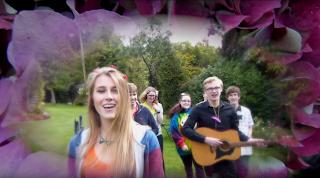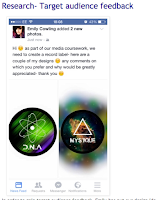Thing-link: Final Cut Pro X breakdown

Construction of our vignette mask on Final Cut Pro X
- In order to incorporate the vignette mask into our music video I had to first open up our project on Final Cut Pro X.
- I then worked with my partner to find the clip that would be used for the vignette mask, we chose to use the backwards tracking shot of Indya and the group of friends following her. Then scroll across two the effects which is in the bottom hand right corner, this features lots of effects to use.
- Then to find the vignette tool we had to use the search bar (at the bottom right) on effects. Where we found the vignette tool, when hovering the mouse over the tool it gives you a preview of the effect. This was quite easy to do and i liked the way the effect can easily be applied to the timeline and then the controls appeared instantly in the viewer. In this way this software was easier to use than Elements 11 in AS, I was pleased with the speed with which i could alter a shot.
- Then we added the effect, as you can see the vignette mask goes onto the time line over the clip, the vignette mask is only slightly darker around the edges and doesn't have an image over it yet, but this will be added afterwards.

- As we wanted a stronger effect onto the underlaying image we upped the blur amount to 2.0 this was the reason of having a thicker vignette mask; so it is more notable. In retrospect i think we could have altered this depending on when we repeated this shot as a softer approach may have changed the connotations.
- We then added the vignette mask tool to the clip, we upped the blur amount, and increased the size of the vignette mask. This was the result of our changes to the mask. The black is where the image will be overlaid. This can be quite challenging, I worked on this for quite some time as when it was too small and Indya moved, we lost her centre frame importance. If it was too large we lost some or most of the flowers. I am pleased with the end result.
- This is the image we chose to use for the vignette mask overlay, we figured it is bright and links into lyrics of the song.
- We then added in an earlier shot we took of flowers in Emily's my garden, we particularly wanted to use this vignette mask as it is an unconventional aspect of our video.
- We then made this shot into a freeze frame as when I replayed the clip there was a slight movement from the camera, by adding a freeze frame we was able to make a still of the shot. We then put the shot of the flowers underneath the timeline of the reverse tracking shot, which allowed the software to cover the black and use the flowers.

- This is the completed shot of the vignette mask used. We feel this worked particularly well as a result, as it enraptured the main lyrics into an unconventional key effect.
I feel the vignette mask was a complete success as it had a professional look gave a clear link between the aural and visual representation, this obvious link further widen our potential target audience as a bigger more mass audience could identify these media techniques. The vignette mask develops thoughts and connotations; this idea first came about when we were brainstorming potential ways in order have lyrics match the visual- the flowers are obviously a key element/symbolic sign [Barthes] for the message of the song. The vignette mask worked as a perfect tool for implementing this in our video. In retrospect, instead of using the same image of flowers twice for the vignette, we could have had another colour that would further push some other indexical symbolic messaging. This would have been achieved by possibly having bright yellow flowers that could establish this sense of warning to the audience- that this potential life path will not be good for her. I am pleased overall with the effect of the vignette however, it could have had a wider spotlight and I could have further altered the blur and size to blend the colours together more fully. One excellent result of this editing technique was that it allowed me to create a still image for the digipak thus developing synergy.
We were met with this message on our mac and after countless efforts to re-upload the footage or trying different macs, all attempts at recovering the work failed. The result was that one of the memory cards was wiped. Thankfully we still had the other footage of that day, but ultimately we were put on the back-foot from day one. This meant that we needed many more shoots to make up for this disaster. In reflection, I feel this fuelled us to strive harder and put more effort into the project to make up the time. It also enabled us and empowered us to reconsider the sequences taken at the shoot and despite losing footage the new shots were even better. I feel we handled this set back brilliantly as we created a music video that still captured our main intention.
Bloopers/out takes
Technological disaster
After a weekend of filming we came back with our two memory cards of footage, whilst uploading them to the mac- the disaster happened.
Bloopers/out takes
Me and my partner created a blooper and out-takes as it highlights our selection and rejection responsibility when editing together our music video.
Bloopers
I believe that this blooper reel expressed how we were very postmodern in the way we created this music video. I was extremely aware of the presence of the camera and the connotations that I could create via media language. I feel this bloopers shows how our creativity was pushed and we were driven to attempt a range of different shots. Some worked well and some didn't. Many shots had to be retaken, not only because of character issues but also due to the weather and at one time lost footage during an upload. Upon reflection I think these out-takes portray development in skills, as it illustrates how difficult some shots tended to be with all the actors/props involved. This in comparison to AS, when we simply had a still image with a model and some props, was a lot more difficult to direct and organise. I feel my skills have developed enormously during this course and that I have a much greater understanding of the importance of pre-production paperwork and preparation as without the shot lists, production breakdowns and storyboards I would have found this production much more difficult.
Prezi and the Research, planning and evaluation stage
I also used Prezi to present product research, this allowed me to create more visually pleasing representations of information, with the use of images, screen captures and videos as well as text to give a more well rounded display of information. By using a small amount of text with the addition of an image with a video as well boosts the level of information that you receive as it isn't just a block of text- in a way you could argue it is rectifying you point more clearly with additional forms of media to get your point across. In AS, I barely used prezi and when I did it was more of an essay in bubbles; I do feel my skills have developed with online software. I have also used prezi in this evaluation in order to organise my response.
Research: Scanned word docs, Celtx - analysis of ancillary products: digipaks, embedded ppt eg Pink, Prezi eg Postmodernism - Jessie J, annotated images. Google and youtube was the most important technology in this phase. I used this to research existing products as they were vital to my understanding of conventions.
Youtube - embedded video was used for research. I enjoyed this, it was useful however, again i found pause and screen capture enabled me to write far more analytically about each shot. This was also more useful as then I had a better idea about the shot type I wanted in my MV.
Planning: For most of the production planning, paper sources were used eg: call sheets, risk assessments, script breakdown, production breakdown, storyboards.
These were all found in the lessons folder on the mac and I was able to upload these, alter them, print and save to numerous files.
CeltX online and installed on our macs was useful at all stages. I found this very easy to use and it was clear.
Powtoon- rough cut of one shot and TA profiling. This was very useful and gave me an idea of the video so far. I was also able to conduct further TA research and ask a focus group for feedback.
 When planning the logo and design I enjoyed using Slidely, Beautiful Photo galleries, this gave me an idea of visual appeal and synergy for the promotional value of the package. This was also a very useful tool for principle photography. It enabled me to view the locations and again develop a sense of the visual appeal.
When planning the logo and design I enjoyed using Slidely, Beautiful Photo galleries, this gave me an idea of visual appeal and synergy for the promotional value of the package. This was also a very useful tool for principle photography. It enabled me to view the locations and again develop a sense of the visual appeal.
Social media was also useful. My partner Emily was able to use her Facebook page to conduct TA research. We both benefitted from this greatly.
Snapchat also enabled us to begin to develop word of mouth and interest in our production.
Planning leading to construction - rough cuts exported from Final Cut Pro X. These were incredibly valuable as I could watch it through and i could also conduct further TA research.
Evaluation: Prezi, text and cut aways. Thing-link was easy to use and I now wish i had used this much earlier. It's a great way of annotating a still image or screen capture.
Preferred style: I believe that my preferred style is mainly taking a still image and analytically picking out media techniques and theories. Although I am highly capable of using a variety of technological tools such as; prezi, powtoon and thinglink, I strongly feel my best work and most helpful for my own understanding comes from strongly breaking down an image to reveal all of its meanings.











Your media terminology and level of analysis is excellent Luke. It's a shame that one image on the prezi covers some of the words and that in the comment above the vlog out takes uploaded video that you have a spelling error. Super Level 4 evaluative comments though Luke.
ReplyDelete